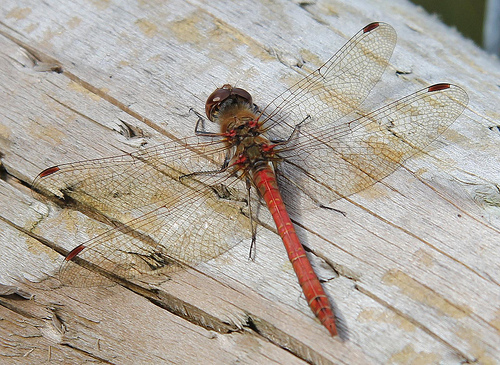Overview
 The order of insects to which dragonflies belong (Odonata) is divided into two sub-orders.
The order of insects to which dragonflies belong (Odonata) is divided into two sub-orders.
The first of these (Anisoptera) includes the large, fast-flying dragonflies while the second (Zygoptera) covers the smaller, slower-flying damselflies.
There are 6,500 named species of
dragonfly worldwide. In Britain and Ireland there are about 30 species of dragonfly and about 20 species of damselfly
Habitat: Wetlands, lakes, ponds, rivers, streams, canals, bogs and ditches.
Lifespan: Over a year from egg stage.
Daily Life
Dragonflies are fast-flying, four-winged insects with long bodies and enormous eyes. The adult dragonfly has the biggest eyes in the insect world and they are capable of detecting movement up to 15m away!
All dragonflies are carnivorous in both the larval and adult stages of their lives. They feed on insect larvae and other smaller water dwellers up to the size of a large tadpole during the larval stage, and then graduate to most flying insects as adults.
 Dragonflies may exist as larvae, or nymphs, from a few months up to five years, depending on the species. During this stage they live entirely under water, mostly in ponds, lakes and canals. The dragonfly's adult life lasts for little more than one month.
Dragonflies may exist as larvae, or nymphs, from a few months up to five years, depending on the species. During this stage they live entirely under water, mostly in ponds, lakes and canals. The dragonfly's adult life lasts for little more than one month.
Having emerged, the adult dragonfly must cling to the plant stem for about two hours, during which time the body and wings harden in readiness for flight.
Male dragonflies have their own territory; they guard their particular stretch of water seeking prey, females and chasing off rivals.
There are two groups of dragonflies; one is known as hawkers: these have long, slim bodies and patrol up and down stretches of water, 'hawking' for prey. The other group is known as darters: these have smaller, fatter bodies than hawkers and spend most of their time clinging to waterside plants, occasionally darting out to catch a passing insect.
The Emperor dragonfly, Anax imperator, has the largest wingspan of any British dragonfly - 10.5cm, and a body length of up to 8cm. (The Golden-ringed dragonfly, Cordulegaster boltonii, has the longest body length of all British dragonflies - up to 8.6cm).
The male emperor is a brilliant blue and the female is greenish - both have a black stripe down the back of the body. It is found in southern England and Wales, around large ponds, canals and lakes during the summer months. It is not found in Scotland or Ireland.
Dragon Flies in Danger
Fifty years ago there were twice as many ponds in Britain as there are today. The draining of agricultural land, filling in and pollution have all contributed to the disappearance of most countryside ponds. Canals have also suffered from pollution, especially by chemicals used on farmland draining into water. The loss of suitable fresh water habitats has affected dragonflies enormously and they are becoming increasingly rare. The Norfolk aeshna, Aeshna isosceles, which can be found living only in the Norfolk Broads, is on the list of Britain's endangered species of insects.
Helping Dragonflies
Garden ponds have become very popular over recent years and these are helping to save Britain's threatened pond-life including dragonflies. Creating a pond habitat in your garden at home, or in your school grounds, is a practical and worthwhile conservation project.
Credits
Image: Dragonflies by Vijay
Information sourced from:
Berger, Cynthia (2004), Wild Guide Dragonflies [online], Available from: https://books.google.co.uk/books?id=oxRD1gAkVVsC&pg=PA2&hl=en#v=onepage&q&f=false [accessed 02/06/2015]
British Dragonfly Society, UK Species [online], Available from: http://www.british-dragonflies.org.uk/content/uk-species [accessed 02/06/2015]
Everything Dinosaur, High Oxygen Levels Spawn Super-sized Dragonflies [online], Available from: https://blog.everythingdinosaur.co.uk/blog/_archives/2010/11/03/4671836.html [Accessed 11/12/2020]
Prehistoric Dragonflies
These fascinating and colourful creatures are among the fastest and oldest insects in the world. Their fossilised remains show that they were already here on earth 300 million years ago!
Fossils of very large dragonfly ancestors from 325 million years ago have been found in in Upper Carboniferous rocks; these had wingspans of up to 750 mm. Insects in these times were able to grow to very large sizes partly due to a lack of predators and partly due to the extra oxygen levels that used to be in the Earth's atmosphere. During the Carboniferous era Earth’s air contained 31-35% oxygen, compared to just 21% oxygen in the air today. Insects don't have lungs, instead, they have a series of openings called 'spiracles' all along their bodies. These carry oxygen to the organs that need it.
Researchers from Arizona State University have carried out an investigation to find out what happens if dragonflies are raised in special chambers with high levels of oxygen, similar to those of the Carboniferous. The team were able to raise dragonflies 15% larger than normal in these chambers.
 The order of insects to which dragonflies belong (Odonata) is divided into two sub-orders.
The order of insects to which dragonflies belong (Odonata) is divided into two sub-orders.
 Dragonflies may exist as larvae, or nymphs, from a few months up to five years, depending on the species. During this stage they live entirely under water, mostly in ponds, lakes and canals. The dragonfly's adult life lasts for little more than one month.
Dragonflies may exist as larvae, or nymphs, from a few months up to five years, depending on the species. During this stage they live entirely under water, mostly in ponds, lakes and canals. The dragonfly's adult life lasts for little more than one month.